IF 11.2
1区 材料科学
Q1 MATERIALS SCIENCE, MULTIDISCIPLINARY
引用次数: 0
摘要
本研究提出了一种利用立体阻碍效应操纵有缺陷金属有机框架(MOFs)的多功能策略,并将其应用于涂层中。以磷酸盐、葡萄糖酸盐和植酸盐为例,利用立体阻碍效应构建了有缺陷的 MOFs。这些缺陷 MOFs 是在室温水溶液中合成的,具有良好的工业应用前景。在 MOFs 中定制特定的缺陷可使聚合物分子链渗入内部骨架,形成互锁结构。互锁效应可增强涂层的机械性能,阴离子的缓蚀性能可协同提高涂层的耐腐蚀性能。嵌入植酸改性 MOF 的水性丙烯酸树脂(WAR)的拉伸强度最高,达到 23.9 兆帕,是纯 WAR 的四倍。防腐测试结果表明,复合涂层在海水中浸泡 2 个月后,其缓蚀效率保持在 97% 左右。实验和分子动力学模拟详细阐述了缺陷工程 MOFs 的结构-性能关系和防腐机理。该策略具有良好的环境友好性,降低了MOF材料的成本,具有广阔的应用前景。本文章由计算机程序翻译,如有差异,请以英文原文为准。

Coatings embedded with composite defective metal organic frameworks having excellent mechanical and anti-corrosion properties
In this work, a versatile strategy of manipulating defective metal organic frameworks (MOFs) with the assistance of the steric hindrance effect was proposed and applied in coatings. The steric hindrance effect was utilized to construct the defective MOFs with phosphate, gluconate and phytate as examples. The defective MOFs were synthesized in an aqueous solution at room temperature, having a promising future for industrial application. Tailoring specific defects in MOFs can make molecular chains of polymer penetrate into the internal skeleton and form an interlocking structure. The interlocking effect can enhance the mechanical performance of the coating, and the corrosion inhibition performance of anions can synergistically improve the corrosion resistance of the coating. The waterborne acrylic resin (WAR) embedded with phytate-modified MOF has the highest tensile strength of 23.9 MPa, four times higher than pure WAR. Anti-corrosion test results indicated that the corrosion inhibition efficiencies of composite coatings maintained around 97% after 2 months of immersion in seawater. The structure-property relations of defect-engineered MOFs and the anti-corrosion mechanisms were elaborated in detail by both experiments and molecular dynamics simulation. This strategy has excellent environmental friendliness, reduces the cost of MOF materials, and has broad application prospects.
求助全文
通过发布文献求助,成功后即可免费获取论文全文。
去求助
来源期刊

Journal of Materials Science & Technology
工程技术-材料科学:综合
CiteScore
20.00
自引率
11.00%
发文量
995
审稿时长
13 days
期刊介绍:
Journal of Materials Science & Technology strives to promote global collaboration in the field of materials science and technology. It primarily publishes original research papers, invited review articles, letters, research notes, and summaries of scientific achievements. The journal covers a wide range of materials science and technology topics, including metallic materials, inorganic nonmetallic materials, and composite materials.
 求助内容:
求助内容: 应助结果提醒方式:
应助结果提醒方式:


